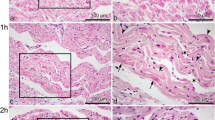Abstract
To better characterize the morphologic changes in electrocution, morphologic changes in the hearts of 21 subjects, who died instantaneously of electrocution, were compared to the hearts of decedents with different types of death. Sixteen myocardial samples per heart were processed for histological examination, and sections were prepared with a variety of specific stains. The frequency, location and extent of myocellular segmentation (stretching and/or rupture) of intercalated discs and associated changes of myocardial bundles and single myocells [myofibre break-up (MFB)] were recorded, quantitatively analysed and statistically evaluated. The frequency of MFB was maximal in cases of electrocution (90%). The findings show that MFB is an ante-mortem change and may be a distinct finding in electrocution.



Similar content being viewed by others
References
Fish R (1993) Electric shock, Part I: nature and mechanisms of injury. J Emerg Med 11:309–312
Wright RK, Davis JH (1980) The investigation of electrical deaths: a report of 220 fatalities. J Forensic Sci 25:514–521
Takamiya M, Saigusa K, Nakayashiki N, Aoki Y (2001) A histological study on the mechanism of epidermal nuclear elongation in electrical and burn injuries. Int J Legal Med 115:152–157
Karger B, Suggeler O, Brinkmann B (2002) Electrocution—autopsy study with emphasis on “electrical petechiae”. Forensic Sci Int 126:210–213
Vianello F (1997) A man in the thunderstorm: coronary injuries and electric shock. Cardiology 88:486
Zipes DP (1975) Electrophysiological mechanisms involved in ventricular fibrillation. Circulation 52(6 Suppl):III120–III130
Baroldi G, Silver MD, Parolini M, Pomara C, Turillazzi E, Fineschi V (2005) Myofiber break-up: a marker of ventricular fibrillation in sudden cardiac death. Int J Cardiol 100:435–441
Fineschi V, Wetli CV, Di Paolo M, Baroldi G (1997) Myocardial necrosis and cocaine. A quantitative morphologic study in 26 cocaine-associated deaths. Int J Legal Med 110:193–198
Baroldi G, Di Pasquale G, Silver MD, Pinelli G, Lusa AM, Fineschi V (1997) Type and extent of myocardial injury related to brain damage and its significance in heart transplantation: a morphometric study. J Heart Lung Transplant 16:994–1000
Fineschi V, Agricola E, Baroldi G et al (2000) Myocardial findings in fatal carbon monoxide poisoning: a human and experimental morphometric study. Int J Legal Med 113:276–282
Fineschi V, Pomara C (2004) A forensic pathological approach to sudden cardiac death. In: Tsokos M (ed) Advances in forensic pathology, vol 1. Humana Press, Totowa, New Jersey, pp 1–32
Ortmann C, Pfeiffer H, Brinkmann B (2000) A comparative study on the immunohistochemical detection of early myocardial damage. Int J Legal Med 113:215–220
Brinkmann B, Sepulchre MA, Fechner G (1993) The application of selected histochemical and immunohistochemical markers and procedures to the diagnosis of early myocardial damage. Int J Legal Med 106:135–141
Fineschi V, Baroldi G, Centini F et al (2001) Markers of cardiac oxidative stress and altered morphology after intraperitoneal cocaine injection in a rat model. Int J Legal Med 114:323–330
Sheppard M, Davies MJ (1998) Practical cardiovascular pathology. Arnold, London Sidney Auckland
James TN, Riddick L, Embry JH (1990) Cardiac abnormalities demonstrated postmortem in four cases of accidental electrocution and their potential significance relative to nonfatal electrical injuries of the heart. Am Heart J 120:143–157
Ross JA, Green HL (1987) Levels of short (1–15 ms) electrical shocks from a 50 Hz supply inducing ventricular fibrillation in hyperbaric helium and oxygen. Br J Ind Med 44:764–768
Fish R (1993) Electric shock, Part II: nature and mechanisms of injury. J Emerg Med 11:457–462
Lichtenberg R, Dries D, Ward K, Marshall W, Scanlon P (1993) Cardiovascular effects of lightning strikes. J Am Coll Cardiol 21:531–536
Xenopoulos N, Movahed A, Hudson P, Reeves WC (1991) Myocardial injury in electrocution. Am Heart J 122:1481–1484
Homma S, Gillam LD, Weyman AE (1990) Echocardiographic observations in survivors of acute electrical injury. Chest 97:103–105
Zack F, Hammer U, Klett I, Wegener R (1997) Myocardial injury due to lightning. Int J Legal Med 110:326–328
Zhang P, Cai S (1995) Study on electrocution death by low-voltage. Forensic Sci Int 76:115–119
Ku CS, Lin SL, Hsu TL, Wang SP, Chang MS (1989) Myocardial damage associated with electrical injury. Am Heart J 118:621–624
Romero B, Candell-Riera J, Gracia RM, Fernandez MA, Aguade S, Peracaula R, Soler-Soler J (1997) Myocardial necrosis by electrocution: evaluation of noninvasive methods. J Nucl Med 38:250–251
Ulibarrena Sainz M, Zuazola P, Santos Calle F, Serrano T, Garcia Redondo B (1996) Differential diagnosis of acute myocardial infarction caused by electrocution. Rev Esp Cardiol 49:470–473
Walton AS, Harper RW, Coggins GL (1988) Myocardial infarction after electrocution. Med J Aust 148:365–367
Guinard JP, Chiolero R, Buchser E et al (1987) Myocardial injury after electrical burns: short and long term study. Scand J Plast Reconstr Surg Hand Surg 21:301–302
Amy BW, McManus WF, Goodwin CW Jr, Pruitt BA Jr (1985) Lightning injury with survival in five patients. JAMA 253:243–245
Zeana CD (1984) Acute transient myocardial ischemia after lightning injury. Int J Cardiol 5:207–209
Jackson SH, Parry DJ (1980) Lightning and the heart. Br Heart J 43:454–457
Jensen PJ, Thomsen PE, Bagger JP, Norgaard A, Baandrup U (1987) Electrical injury causing ventricular arrhythmias. Br Heart J 57:279–283
Vanderwee MA, Humphrey SM, Gavin JB, Armiger LC (1981) Changes in the contractile state, fine structure and metabolism of cardiac muscle cells during the development of rigor mortis. Virchows Arch B Cell Pathol Mol Pathol 35:159–167
Klintschar M, Stiller D (2004) Sudden cardiac death in hereditary hemochromatosis: an underestimated cause of death? Int J Legal Med 118:174–177
Hamilton SJ, Sunter JP, Cooper PN (2005) Commotio cordis—a report of three cases. Int J Legal Med 119:88–90
Pomara C, D'Errico S, Riezzo I, de Cillis GP, Fineschi V (2005) Sudden cardiac death in a child affected by Prader–Willi syndrome. Int J Legal Med 119:153–157
Acknowledgements
Supported by a grant of Monte dei Paschi Foundation, Siena, Italy.
Author information
Authors and Affiliations
Corresponding author
Rights and permissions
About this article
Cite this article
Fineschi, V., Karch, S.B., D'Errico, S. et al. Cardiac pathology in death from electrocution. Int J Legal Med 120, 79–82 (2006). https://doi.org/10.1007/s00414-005-0011-8
Received:
Accepted:
Published:
Issue Date:
DOI: https://doi.org/10.1007/s00414-005-0011-8




